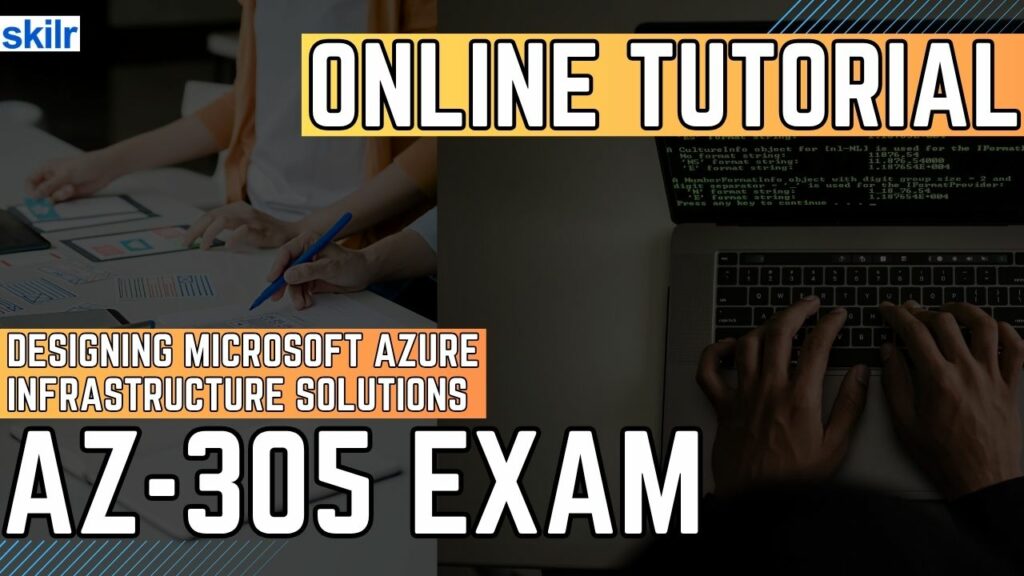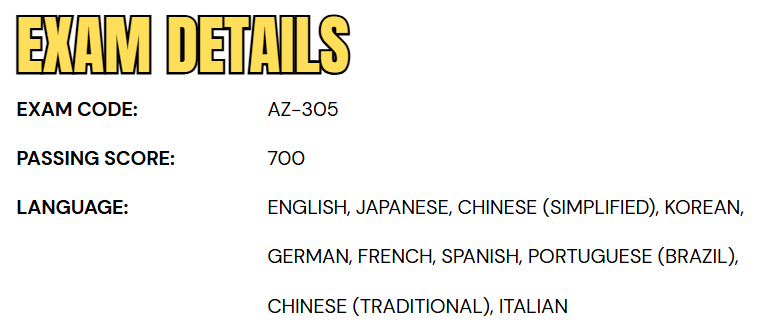
The AZ-305 certification exam is tailored for experienced Microsoft Azure Solutions Architects. It validates your expertise in designing both cloud-based and hybrid solutions that are deployed on Microsoft Azure. These designs encompass core architectural components such as:
- Compute
- Networking
- Storage
- Monitoring
- Security
As an Azure Solutions Architect, your primary responsibility is to collaborate with stakeholders to interpret business goals and transform them into effective, scalable Azure solutions. Your solutions must adhere to Microsoft’s best practices, including the Azure Well-Architected Framework and the Cloud Adoption Framework for Azure.
Your role also involves collaborative implementation, working closely with professionals in other key roles, including:
- Azure Developers
- System Administrators
- Security Engineers
- Data Engineers
– Required Skills and Experience
To be successful in this role and prepared for the AZ-305 exam, you should have:
- Comprehensive IT operations knowledge, covering areas such as:
- Networking and virtualization
- Identity and access management
- Security best practices
- Business continuity and disaster recovery
- Data platforms and governance models
- A strategic mindset, understanding how decisions in each domain impact the broader architectural solution.
Additionally, candidates are expected to have hands-on experience with:
- Azure administration and development
- DevOps methodologies and workflows
Exam Details

- The AZ-305 exam is available in multiple languages to accommodate a global audience. Supported languages include English, Japanese, Simplified Chinese, Korean, German, French, Spanish, Brazilian Portuguese, Traditional Chinese, and Italian.
- To successfully pass the exam, candidates must achieve a minimum score of 700 on a scale of 1 to 1000.
- For individuals who require special assistance—such as additional time, the use of assistive technologies, or any other modifications to the standard testing environment—accommodations can be requested through the official exam provider to ensure an inclusive testing experience.
Course Outline
The exam covers the following topics:
1. Designing Identity, Governance, and Monitoring Solutions (25-30%)
Designng a solution for logging and monitoring
- Recommending a logging solution
- Recommending a solution for routing logs (Microsoft Documentation: Gateway Routing pattern)
- Recommending a monitoring solution
Designing authentication and authorization solutions
- Recommending an authentication solution
- Recommending an identity management solution (Microsoft Documentation: Microsoft Identity Manager 2016 news and updates)
- Recommend a solution for authorizing access to Azure resources
- Recommending a solution for authorizing access to on-premises resources
- Recommend a solution to manage secrets, certificates, and keys
Designing governance
- Recommending a structure for management groups, subscriptions, and resource groups, and a strategy for resource tagging
- Recommending a solution for managing compliance
- Recommending a solution for identity governance
2. Designing Data Storage Solutions (20-25%)
Designing a data storage solution for relational data
- Recommending a solution for storing relational data
- Recommending a database service tier and compute tier
- Recommending a solution for database scalability (Microsoft Documentation: Dynamically scale database resources with minimal downtime)
- Recommending a solution for data protection
Designing data storage solutions for semi-structured and unstructured data
- Recommending a solution for storing semi-structured data (Microsoft Documentation: Choose a big data storage technology in Azure)
- Recommending a solution for storing unstructured data
- Recommending a data storage solution to balance features, performance, and costs
- Recommending a data solution for protection and durability (Microsoft Documentation: Azure customer data protection)
Designing data integration
- Recommending a solution for data integration (Microsoft Documentation: Integrate data into Microsoft Dataverse)
- Recommending a solution for data analysis (Microsoft Documentation: Advanced analytics architecture)
3. Designing Business Continuity Solutions (15-20%)
Designing a solution for backup and disaster recovery
- Recommending a recovery solution for Azure and hybrid workloads that meets recovery objectives
- Recommending a backup and recovery solution for compute (Microsoft Documentation: Azure Backup service)
- Recommending a backup and recovery solution for databases (Microsoft Documentation: Back Up and Restore of SQL Server Databases)
- Recommending a backup and recovery solution for unstructured data (Microsoft Documentation: Azure Storage archive, backup, and disaster recovery partners)
Designing for high availability
- Recommending a high availability solution for compute (Microsoft Documentation: Build solutions for high availability using availability zones)
- Recommend a high availability solution for relational data storage (Microsoft Documentation: High availability for Azure SQL Database and SQL Managed Instance)
- Recommending a high availability solution for semi-structured and unstructured data
4. Designing Infrastructure Solutions (30-35%)
Designing a compute solution
- Specifying components of a compute solution based on workload requirements
- Recommending a virtual machine-based compute solution (Microsoft Documentation: Windows virtual machines in Azure)
- Recommending a container-based compute solution (Microsoft Documentation: Choose an Azure compute service for your application)
- Recommending a serverless-based compute solution (Microsoft Documentation: Serverless computing)
- Recommend a compute solution for batch processing
Designing an application architecture
- Recommend a messaging architecture (Microsoft Documentation: Asynchronous messaging options in Azure)
- Recommending an event-driven architecture (Microsoft Documentation: Event-driven architecture style)
- Recommending a solution for API integration (Microsoft Documentation: API Management)
- Recommending a caching solution for applications (Microsoft Documentation: Caching)
- Recommending an application configuration management solution (Microsoft Documentation: Configuration Manager)
- Recommending an automated deployment solution for your applications (Microsoft Documentation: Deployment considerations for DevOps)
Designing migrations
- Evaluating a migration solution that leverages the Microsoft Cloud Adoption Framework for Azure (Microsoft Documentation: Get started with the Cloud Adoption Framework)
- Evaluating on-premises servers, data, and applications for migration
- Recommending a solution for migrating workloads to infrastructure as a service (IaaS) and platform as a service (PaaS)
- Recommending a solution for migrating databases (Microsoft Documentation: Azure Database Migration Service)
- Recommending a solution for migrating unstructured data (Microsoft Documentation: Azure Storage migration overview)
Designing network solutions
- Recommending a connectivity solution that connects Azure resources to the internet (Microsoft Documentation: Azure networking services overview)
- Recommending a connectivity solution that connects Azure resources to on-premises networks (Microsoft Documentation: Connect an on-premises network to a Microsoft Azure virtual network)
- Recommending a solution to optimize network performance
- Recommending a solution to optimize network security (Microsoft Documentation: Azure best practices for network security)
- Recommending a load balancing and routing solution (Microsoft Documentation: Understand Azure load balancing)
Microsoft AZ-305 Exam FAQs
Microsoft Certification Exam Policies
Microsoft maintains a standardized and transparent set of certification exam policies to ensure fairness, protect the integrity of its exams, and provide a consistent testing experience for all candidates. These policies are uniformly enforced across all exam formats, whether taken remotely with online proctoring or in person at authorized testing centers.
– Exam Retake Policy
Candidates who do not pass an exam on their initial attempt must wait at least 24 hours before retaking it. For any additional retakes, a 14-day waiting period is required between attempts. Microsoft allows a maximum of five attempts per exam within 12 months. Once a candidate successfully passes an exam, further attempts are not permitted unless recertification is necessary due to exam expiration. Please note that standard exam fees apply to each attempt, including retakes.
– Rescheduling and Cancellation Policy
Candidates may reschedule or cancel their exam appointment at no cost if the request is submitted at least six business days before the scheduled date. Changes made within five business days of the exam may be subject to a rescheduling or cancellation fee. If the appointment is canceled within 24 hours of the exam or the candidate fails to attend, the full exam fee will be forfeited.
Microsoft AZ-305 Exam Study Guide

Step 1: Understand the Exam Objectives
Start your preparation by thoroughly reviewing the AZ-305 exam objectives provided by Microsoft. These objectives outline the specific skills and knowledge areas the exam will assess. Focus on core domains such as designing identity and governance solutions, data storage strategies, business continuity plans, and infrastructure solutions. Understanding what the exam covers will help you identify knowledge gaps and plan your study approach accordingly.
Step 2: Use Microsoft’s Official Learning Paths
Microsoft provides both self-paced learning paths and instructor-led training to help candidates prepare. The self-paced modules are free, comprehensive, and allow you to learn at your own pace. They are ideal for building foundational knowledge and reinforcing concepts. The modules include:
- Understand about Microsoft Azure Architect Design Prerequisites
- Designing identity, governance, and monitor solutions
- Designing business continuity solutions
- Overview of designing data storage solutions
- Designing infrastructure solutions
- Building great solutions with the Microsoft Azure Well-Architected Framework
- Accelerating cloud adoption with the Microsoft Cloud Adoption Framework for Azure
Furthermore, for those who prefer guided learning, instructor-led courses offer real-time interaction with certified trainers and structured learning environments, making them suitable for deepening your expertise and clarifying complex topics. This course prepares Azure Solution Architects to design end-to-end infrastructure solutions on Microsoft Azure. It covers key areas such as compute, networking, storage, governance, identity, and business continuity, using a mix of lectures and case studies. It is designed for professionals with prior Azure deployment experience and strong foundational knowledge of Azure services and application design principles.
Step 3: Join Study Groups and Community Forums
Participating in study groups and online forums can significantly enhance your learning experience. These platforms provide opportunities to engage in discussions, share resources, and clarify doubts with fellow exam candidates or Azure professionals. Platforms such as Microsoft Learn Community, LinkedIn groups, and Reddit’s Azure subreddit often host active discussions and can be valuable for staying updated on exam experiences and industry practices.
Step 4: Apply Knowledge Through Hands-On Practice
Designing Azure infrastructure solutions requires more than theoretical knowledge. Set up a free Azure account or sandbox environment to apply what you’ve learned. Practice designing and implementing architecture scenarios based on real-world business needs. Hands-on experience will not only solidify your understanding but also prepare you for the practical nature of many exam questions.
Step 5: Take Official Practice Tests
Once you have a good grasp of the topics, assess your readiness by taking official or reputable AZ-305 practice tests. These simulations help you become familiar with the exam format, question types, and time constraints. Analyze your performance to identify weak areas, then revisit those topics using Microsoft Learn resources or training content. Repeat this process until you consistently achieve a high score on practice exams.
Step 6: Final Review and Exam Readiness
In the final days before your exam, focus on reviewing key concepts, architectural best practices, and Azure frameworks like the Well-Architected Framework and the Cloud Adoption Framework. Use flashcards, mind maps, or summary notes to revisit important points quickly. Ensure your exam logistics, such as testing location or remote setup, are confirmed in advance to avoid last-minute issues.


